Immersed in the marsh: New student field orientation at W&M’s Batten School & VIMS is an unparalleled introduction to hands-on research
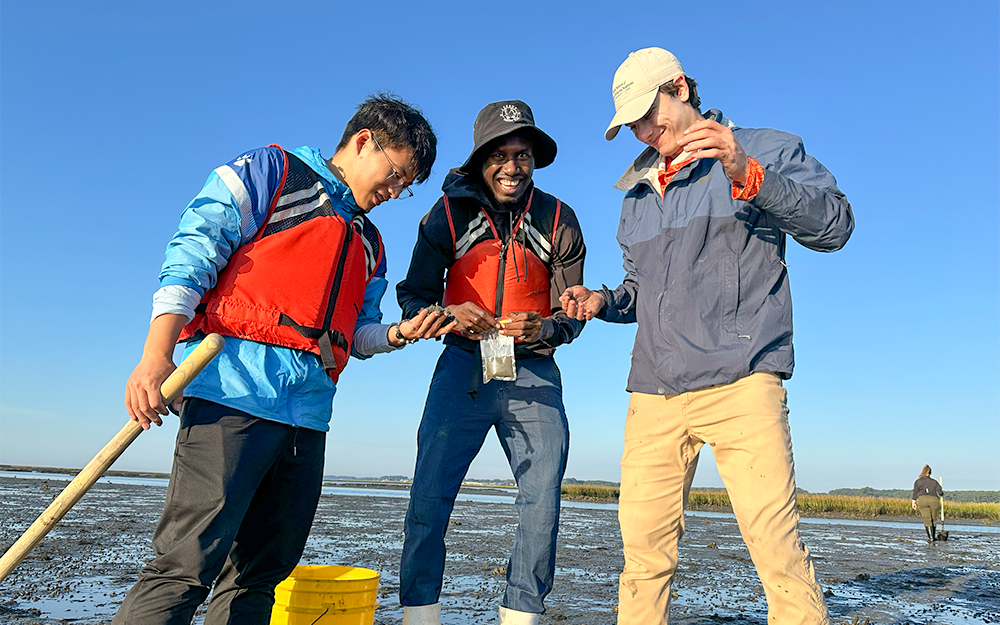 The first month of graduate school is always filled with new experiences. For M.A., M.S. and Ph.D. students at William & Mary’s Batten School & VIMS, one highlight is an awe-inspiring new student orientation field trip to the barrier island environment of Virginia’s Eastern Shore.
The first month of graduate school is always filled with new experiences. For M.A., M.S. and Ph.D. students at William & Mary’s Batten School & VIMS, one highlight is an awe-inspiring new student orientation field trip to the barrier island environment of Virginia’s Eastern Shore.
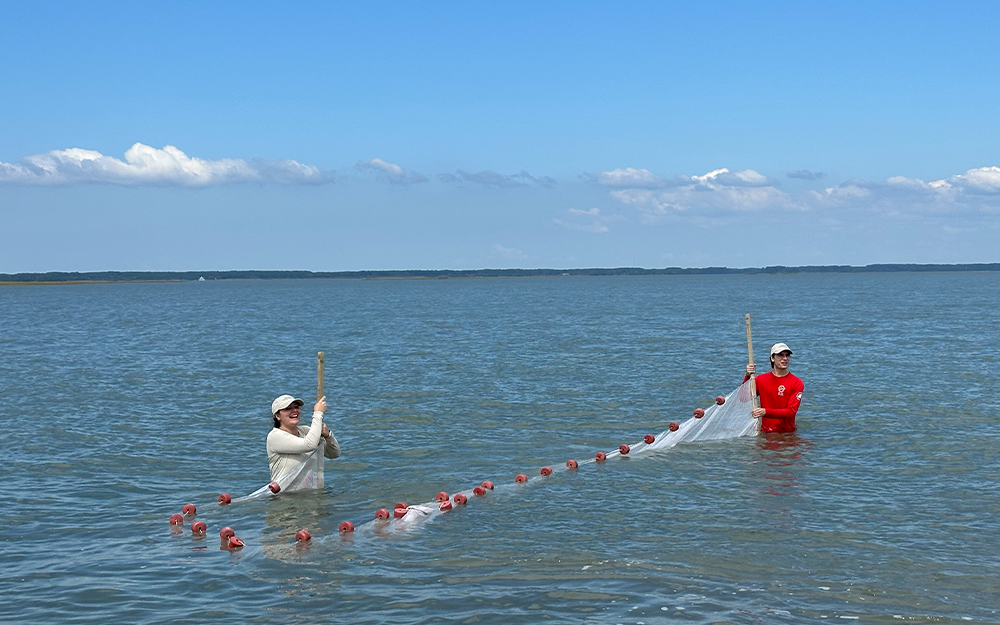
During a recent mid-September weekend, 17 first-year graduate students loaded into vans and departed the Batten School of Coastal & Marine Sciences' Gloucester Point campus for the VIMS Eastern Shore Laboratory (ESL) in Wachapreague, VA, their home base for a weekend of immersive learning.
Throughout the weekend, students visited a wildlife refuge, explored mudflats, trekked across a barrier island, collected live animals and algae, analyzed specimens in the lab and created unforgettable memories with both peers and instructors.
“Being able to experience this with everyone as a cohort has been really amazing,” said M.S. student Katherine Kivimaki ’24. “The sense of community I've gotten with these first-years has been unlike anything I've had in the past. And there's no better way to learn. You can hear a lecture a thousand times in a classroom, and it won't stick nearly as well as the things that you're able to experience out in the field.”
“That’s exactly what the new student orientation field trip at the VIMS ESL is designed to do,” said Siddhartha Mitra Ph.D. ’97, associate dean for academic affairs. “We aim to not only introduce students to Eastern Shore ecosystems and establish a foundation of field research methodologies, but also help create a supportive cohort camaraderie that will sustain them throughout their time at the Batten School & VIMS.”
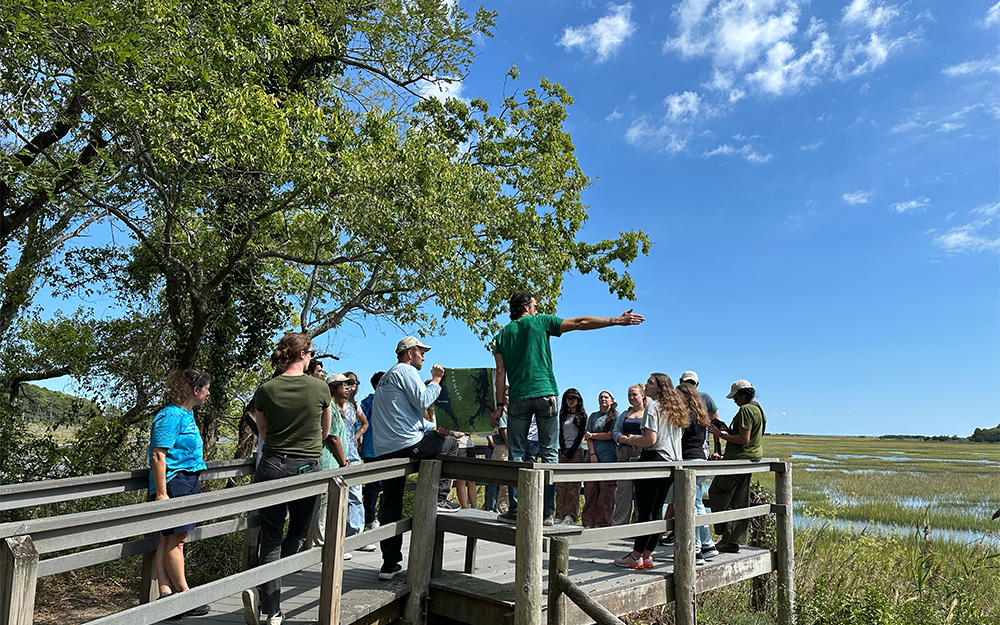
Experiencing the Eastern Shore firsthand
While en route to VIMS ESL on Friday, September 12, trip participants detoured to visit the Eastern Shore of Virginia National Wildlife Refuge, as well as the Barrier Islands Center, to learn more about the region’s unique geology, history and culture.
Once on campus, VIMS ESL Director Richard Snyder and Assistant Director Stacy Krueger-Hadfield, both professors at the Batten School, welcomed the group with a campus tour. The evening concluded with a cookout and spirited Eastern Shore-themed trivia night led by graduate assistants.
“It was really cool to see the different facilities and the potential lab spaces available to us,” said M.S. student Elizabeth Oliver. “It’s amazing how willing they are to evolve the lab to basically fit what you need for research.”
Making memories in the mud
Saturday brought the heart of the experience: fieldwork on the water, in the marsh and on a barrier island. At the break of dawn, students suited up with safety gear and boarded skiffs that carried them through some of the region's most dynamic marsh habitats.
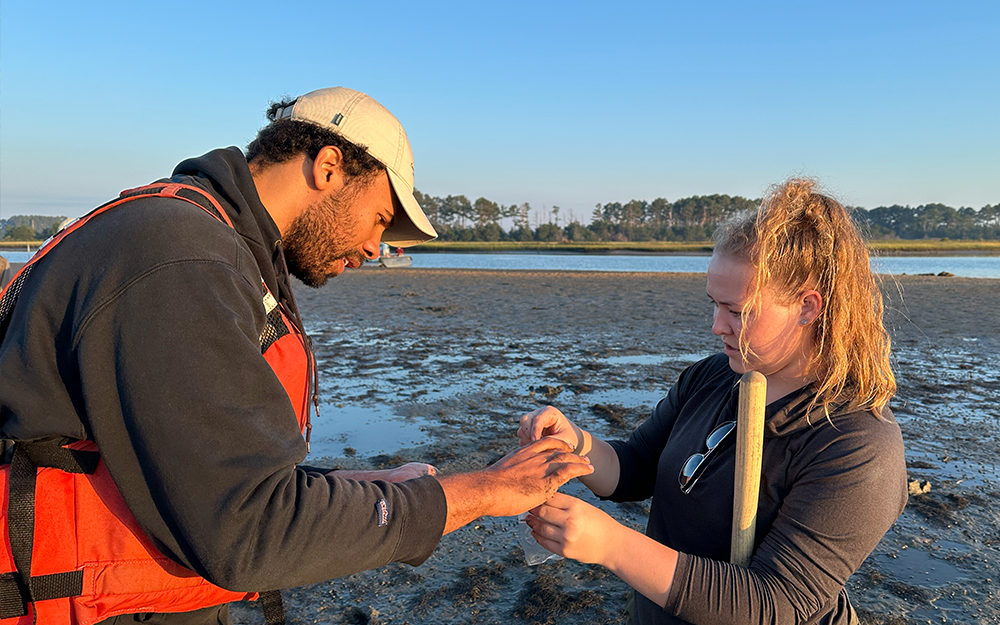 The cohort first landed on a mudflat at low tide, where Krueger-Hadfield led students in collecting samples. After instruction, participants spread out and gathered specimens of fiddler crabs, tube worms and mud snails, among others.
The cohort first landed on a mudflat at low tide, where Krueger-Hadfield led students in collecting samples. After instruction, participants spread out and gathered specimens of fiddler crabs, tube worms and mud snails, among others.
Students were then brought together for lessons in coastal geology and sedimentology by Gloucester Point-based Professors Chris Hein and Sarah Black, who discussed the abundance of information that can be derived by simply examining the sand and mud under participants’ feet.
Developing those observational skills was a standout moment for M.S. student Jonathan Williams. “Learning how you can really understand an area by just looking at what’s around you was great,” he said. “And now that I know what I know, I'm going to appreciate that a lot more when I'm in the field, or at the beach or anywhere.”
Back in the research vessels, students had the chance to experience sample collection via trawling. The nets brought in a range of Eastern Shore species, from spot, cobia and anchovy to blue crabs and a large cownose ray.
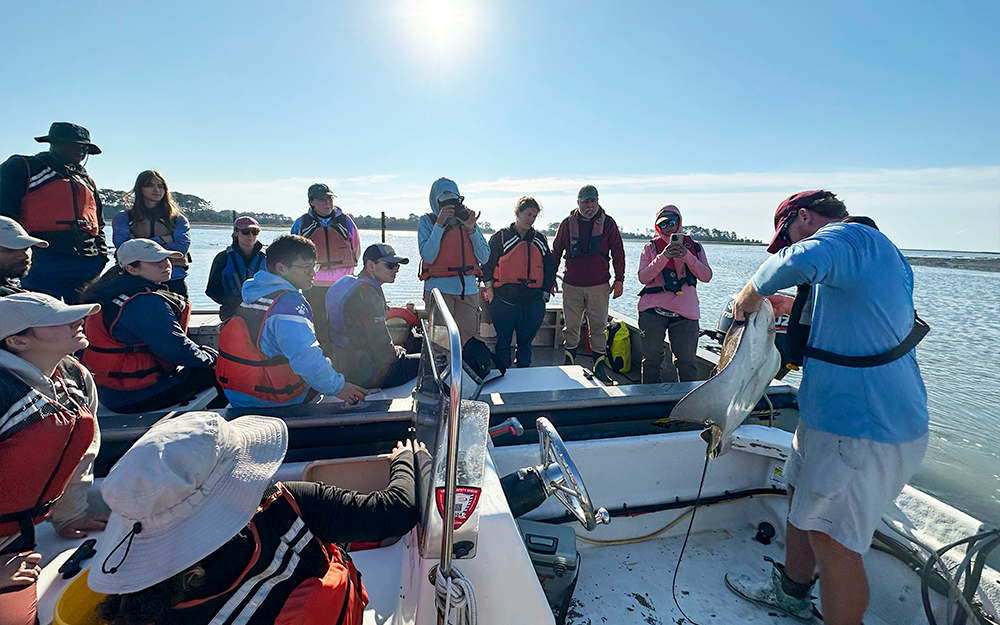 As students looked on with fascination, the vessel operators for the field trip — VIMS ESL Seawater Lab Manager John Lewis and Senior Marine Scientist P.G. Ross — provided tutorials on the biology and ecology of the collected organisms.
As students looked on with fascination, the vessel operators for the field trip — VIMS ESL Seawater Lab Manager John Lewis and Senior Marine Scientist P.G. Ross — provided tutorials on the biology and ecology of the collected organisms.
Barrier islands reveal coastal change & ecology
Following a brief return to shore to deposit samples, boats were re-launched toward the southern tip of Cedar Island, one of 14 almost entirely undeveloped barrier islands off the coast of Virginia. Students had a much-needed moment to relax as they enjoyed a packed lunch on the sandy beach before becoming immersed in another geology lecture.
Hein explained the phenomena of Cedar Island’s transformation and migration over time, as climatological forces are causing island rollover and pushing it increasingly closer to the Eastern Shore peninsula at an accelerating pace.
The cohort then traversed across the shell blanketed landscape to the seaside of the island. With the Atlantic as their backdrop, Hein and second-year Ph.D. student Matt McCormick led students in digging a temporary trench as they explained a variety of coastal geomorphic and sediment transport processes and examined deposits left on the beach by recent storms.
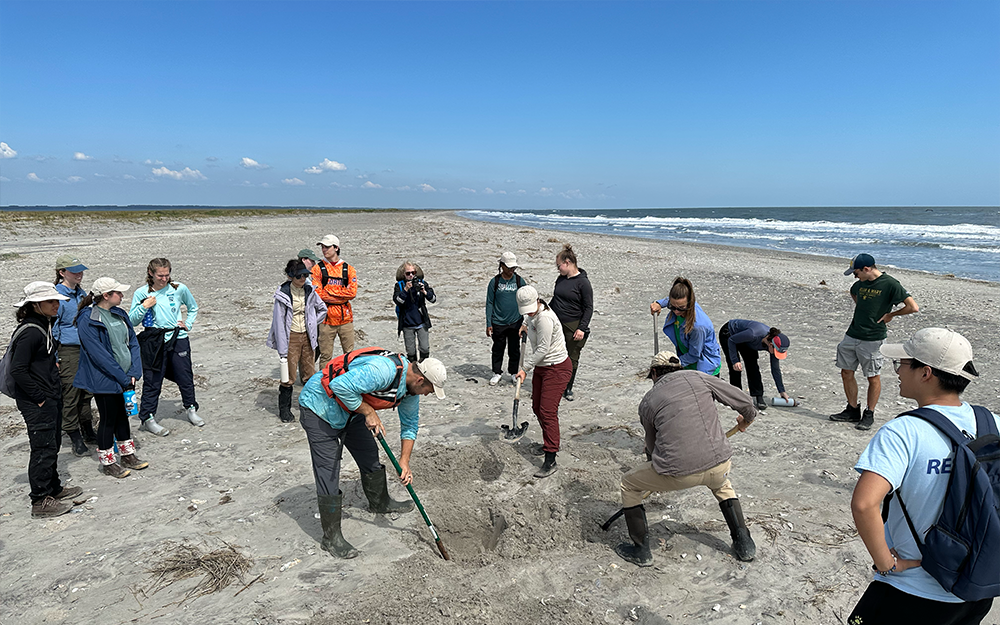
“That was great, because I’m not usually in the geology field,” said Oliver, “It was like taking a mini-geo course.”
A return to the other side of the island brought a period of sein net fishing guided by Krueger-Hadfield before the group departed back to VIMS ESL. Along the way, a final set of samples were collected via dredging, which returned oyster shells, boring sponges and Atlantic purple sea urchins.
Once participants returned to the lab, field specimens came under closer examination. Krueger-Hadfield, Hein and Black, alongside graduate assistants McCormick, Xander Geragotelis and Jessica Fergel, guided students through microscope use and analysis, showing how samples from the field translate into research questions and data sets that advance coastal science.
Appreciating a lasting foundation for research
Saturday ended with a multi-course seafood feast graciously prepared by VIMS ESL staff and shared by students, faculty and staff, celebrating both regional traditions and the successful culmination of the weekend’s exhaustive field work.
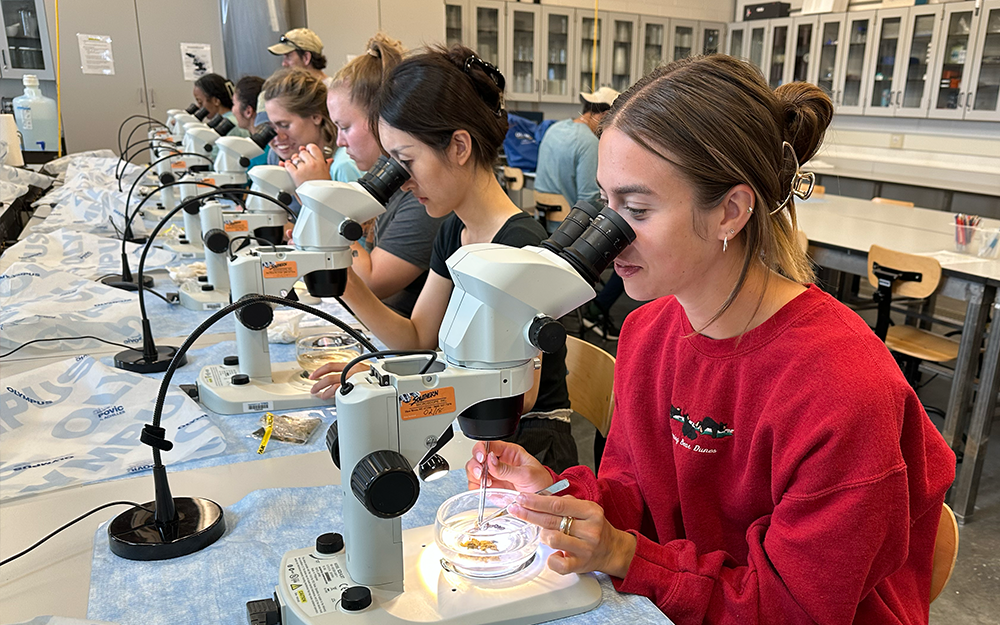
Reflecting on the trip, Hein summarized that it had a threefold purpose: “First, students had the opportunity to visit the VIMS Eastern Shore Lab and understand what the facility and staff are about and what they can offer. Second, the cohort really got to know each other while climbing over mudflats, which is very different than sitting in a room doing icebreakers. And third, it was a way to explore, hands-on, the topics that they’re learning about in classes.”
Hein continued, “What's really great about the Eastern Shore is you have not only a world-class field research and educational facility, but one located within a dynamic environment experiencing constant change. You have barrier islands migrating, marshes eroding in some places and growing elsewhere, different species across the landscape, and changes throughout the season. To experience all of that gives them a new understanding of what interdisciplinary marine science is, which is what we do at VIMS.”
By Sunday morning, the cohort departed Wachapreague with sandy boots, new knowledge and lasting relationships. More than a simple orientation, the Eastern Shore field trip set the tone for the students’ time at the Batten School & VIMS: hands-on, interdisciplinary and deeply connected to the local ecosystems and communities in which their graduate studies and research will take place.

